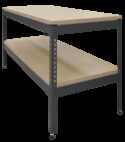Experiment
SM1004

BEAM APPARATUS
A bench top frame with load cells and cantilevers for the study of deflection and forces on different types of beams for a wide range of supports and loads; also demonstrates Young's modulus.
If you have any questions or you'd like to discuss a product, please call us.
+44 1159 722 611BEAM APPARATUS
The Beam Apparatus allows an extensive range of experiments to cover virtually all course requirements relating to bending of beams. The basic unit provides facilities for supporting beams on simple, built-in and sinking supports, applying point loads, and measuring support reactions and beam deflections. It includes five different test beams. A pack of ten additional beams (SM1004a) is available for further experiments.
The Beam Apparatus can be used for an almost limitless number of experiments ranging from determination of the elastic modulus for beams of different materials, through to studies of continuous beams with any loading. Great care has been taken at the design stage to ensure maximum flexibility and ease of use.
The main frame of the apparatus consists of an upper cross-member carrying graduated scales and two lower members bolted to T-legs to form a rigid assembly. The three load cells and cantilever-support pillar slide along the lower members and can be clamped firmly in any position. The load cells have direct digital readout and each is fitted with a hardened steel knife edge which can be adjusted to set the initial level or to simulate a sinking support. Locking pins can convert each load cell to a rigid support when required.
The cantilever support is a rigid pillar with a sturdy clamping arrangement to hold the beams when built-in end conditions are required. Four weight hangers and a set of weights are supplied to apply static loads. Three digital indicators measure all beam deflections. The indicators mount on magnetic carriers that slide along the upper cross-member. The indicators, carriers, load cells and weight hangers all have cursors that register on the scale (located on the upper cross-member) to ensure easy, accurate positioning. All digital indicators and load cells have sockets and cables for connection to TecQuipment’s optional Versatile Data Acquisition System (VDAS®).
The standard test beams are in three thicknesses and include three different materials. They are suitable for the complete range of experiments covering different loading and support configurations. The optional set of beams provide for experiments on different types of beam including compound, channel and non-uniform beams of various materials.
The Beam Apparatus comes with a comprehensive user guide.
For quick and reliable tests, TecQuipment’s optional VDAS® gives accurate real-time data capture, monitoring and display, calculation and charting of all important readings on a computer.
Learning outcomes
- Verification of the bending equation
- Determination of flexural rigidity and elastic modulus (Young’s modulus)
- Verification of static equilibrium
- Deflection of beams on two simple supports with point loads
- Reciprocal properties for loads and deflection
- Simple and propped cantilevers with any loading
- Continuous beams: statically indeterminate cases for simply supported beams and cantilevers on more than two supports with any loading (including measurement of unknown reactions)
- Simply supported and cantilever beams with sinking supports -
With the SM1004a Specimen Beams, these additional experiments can be done:
- The effects of material and section shape on flexural rigidity
- Bending characteristics of a brass/steel compound beam, with and without shearing connection between the two layers
- Equivalent sections – characteristics of a metal-faced wooden beam
- Deflections on a non-uniform (tapered) beam or cantilever






















